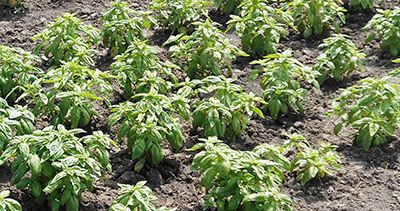Ocimum basilicum var. Dark Green


| ENG | basil |
| SK | bazalka pravá |
| CZ | bazalka pravá |
| PL | bazylia pospolita |
| HU | bazsalikom |
Using
Traditionally it is used in folk medicine as a remedy for a large number of diseases, including cancer, convulsion, diarrhoea, epilepsy, gout, nausea, sore throat, toothaches, and bronchitis. Basil contains high levels of phenolic acids that contribute to its strong antioxidant capacity. Phenolic acids – such as rosmarinic, chicoric, caffeic, and caftaric acids – are found in high concentrations in numerous basil cultivars. According to study of European Journal of Clinical Nutrition, the dried sweet basil belongs between the 100 richest foods in polyphenols and antioxidants and it is on 26Th position in the frame of this chart. Antioxidant properties of basil are in high rate connected with essential oils. Ocimum basilicum L. is the most important species being utilized as a source of essential oil. Due to its pleasant aroma and antimicrobial activity, basil essential oil is a major aromatic agent with applications in various industries such as the food, pharmaceutical, cosmetic, and aromatherapy industries.
| I. | II. | III. | IV. | V. | VI. | VII. | VIII. | IX. | X. | XI. | XII. | |||||||||||||
| Sowing | ||||||||||||||||||||||||
| Planting | ||||||||||||||||||||||||
| Harvest | ||||||||||||||||||||||||
Botanical description and occurrence:
Green leafy variety was bred in Italy. It is an aromatic, annual herb with large oval leaves, dark green colored, and glossy, serrated. It reaches a height of up to 0.6 to 0.7 meters. Erect stem branches well. Inflorescences are white. It is characterized by a biting spicy sweet flavor and taste.
Why to have the plant in your garden:
Sweet salad basil Dark Green belongs to culinary, medicinal and also ornamental herbs with many of health positive properties due to its qualitative characteristics. As a spice it has been used mainly in Mediterranean cuisine.
Text:
prof. RNDr. Alžbeta Hegedúsová, PhD., Dr. Ivana Mezeyová, SUA, Nitra, Slovak Republic
Photo:
Dr. Ivana Mezeyová, SUA, Nitra, Slovak Republic

